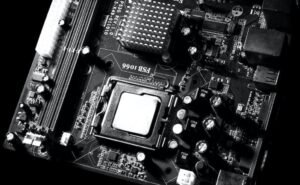Video Generative Adversarial Network
A Video Generative Adversarial Network (VGAN) is a machine learning framework that incorporates generative adversarial networks (GANs) to generate artificial video content.
Key Takeaways
- VGANs use GANs to generate realistic video content.
- They have various applications in entertainment, virtual reality, and video editing.
- VGANs rely on two neural networks, a generator, and a discriminator.
- Training VGANs can be challenging due to the size and complexity of video data.
A GAN is a type of neural network architecture comprising two networks: a generator and a discriminator, which work in tandem to improve the quality of generated outputs. In the case of VGANs, these outputs are videos. The generator learns to produce realistic video content by transforming random noise into video frames, while the discriminator’s role is to distinguish between real and generated videos. The generator and discriminator engage in a continuous adversarial game, iteratively improving their respective abilities.
Generating Realistic Videos
One of the biggest challenges in video generation is to produce content that is visually indistinguishable from real videos. VGANs address this challenge by introducing spatial and temporal coherence to the generated frames, creating a smooth and realistic video experience. By leveraging the capabilities of GANs, VGANs have the potential to revolutionize various industries, including entertainment, virtual reality, and video editing.
With VGANs, it becomes possible to generate new video content that is virtually indistinguishable from real footage.
Training the VGAN
Due to the size and complexity of video data, training VGANs is a computationally intensive process. To achieve good results, a large dataset of real video footage is required for effective training. With the availability of large-scale video datasets and advances in computing power, researchers have been able to train VGANs that produce highly realistic video sequences. However, challenges such as video distribution diversity and long-term temporal consistency still need to be addressed for further improvements.
Training VGANs involves iterative optimization of the generator and discriminator networks to produce high-quality video content.
Applications of VGANs
VGANs have a wide range of applications:
- Entertainment: VGANs can generate fictional video characters, generate realistic video game content, and provide immersive experiences in virtual reality.
- Video Editing: VGANs can enhance and manipulate video content, allowing for easy removal of unwanted objects, scene modification, or realistic simulation of specific visual effects.
- Surveillance and Security: VGANs can be used to generate synthesized video footage for training surveillance systems and testing security protocols.
VGANs have the potential to transform industries by providing new ways to create, modify, and enhance video content.
Data & Research
| Research | Dataset | Results |
|---|---|---|
| Video Prediction using Multiscale Deep Generative Models | UCF-101 dataset | Generated videos closely resemble real footage with high prediction accuracy. |
| Unsupervised Cross-dataset Transfer Learning for Video Action Recognition | Kinetics dataset | VGAN achieved state-of-the-art performance with improved cross-dataset recognition. |
Challenges and Future Directions
While VGANs have shown impressive capabilities, there are still challenges and opportunities for further research and development in this field:
- Realistic Dynamics: Enhancing the realism of moving objects and complex actions in generated videos.
- Long-Term Dependencies: Improving long-term temporal consistency in video sequences.
- User-Guided Generation: Enabling users to interactively guide VGANs to generate specific video content.
Conclusion
Video Generative Adversarial Networks (VGANs) have emerged as a powerful tool for generating realistic video content. By leveraging the capabilities of GANs, VGANs have the potential to revolutionize various industries, ranging from entertainment and virtual reality to video editing and surveillance. While challenges remain, ongoing research and development in VGANs create exciting possibilities for the future of video content generation and manipulation.

Common Misconceptions
Misconception 1: Video Generative Adversarial Networks (VGANs) are only used for deepfake creation
One common misconception about VGANs is that they are solely used for creating deepfakes, where someone’s face is swapped onto another person’s body in video or image footage. While VGANs can be used for deepfake creation, they have other practical applications as well.
- VGANs can be used for video enhancement and superresolution, improving the quality of low-resolution videos.
- They can generate synthetic training data for machine learning models, aiding in object recognition and video analysis tasks.
- VGAN techniques can also be employed in video summarization, generating concise summaries of longer videos.
Misconception 2: VGANs are only beneficial for entertainment purposes
Another misconception is that VGANs are primarily used for entertainment purposes, such as creating realistic avatars or generating video game characters. While VGANs do have applications in the entertainment industry, their usefulness extends beyond just entertainment.
- VGANs are employed in video surveillance systems to enhance the quality of surveillance footage and detect anomalies or suspicious activities.
- They are utilized in medical imaging to generate synthetic data for training algorithms and improving diagnostic accuracy.
- VGANs also contribute to video compression techniques, optimizing video file sizes without significant loss in quality.
Misconception 3: VGANs are difficult to train and require extensive computational resources
One misconception is that VGANs are incredibly difficult to train and require massive computational resources. While VGAN training can be resource-intensive, advancements in hardware and software have made the process more accessible.
- Modern graphics processing units (GPUs) can accelerate VGAN training, reducing the time required for convergence.
- Transfer learning techniques can be utilized to speed up VGAN training by leveraging pre-trained models and fine-tuning them for specific video generation tasks.
- Efficient implementation of VGAN architectures and optimization algorithms can minimize resource requirements while achieving good results.
Misconception 4: VGANs always produce realistic and accurate video outputs
It is a misconception to assume that VGANs always produce highly realistic and accurate video outputs. In reality, the quality of the generated videos can vary depending on several factors.
- Noise or imperfections in the training data can result in artifacts or inconsistencies in the generated videos.
- If not properly trained or validated, VGANs may produce videos with unrealistic or distorted content.
- The complexity and variability of real-world scenes can pose challenges for VGANs to generate photorealistic videos consistently.
Misconception 5: VGANs will replace human video content creation
A common misconception about VGANs is that they will eventually replace human video content creation altogether. While VGANs have made significant advancements in generating video content, human creativity and expertise remain essential for many video production tasks.
- VGANs are often used as a tool to assist human content creators, providing suggestions, enhancing existing footage, or generating rough drafts.
- The ability for VGANs to generate videos autonomously without human supervision is limited, and they rely on human guidance and creative decision-making.
- Human creators add the artistic touch and storytelling elements that are crucial for captivating and engaging video experiences.

Video Generative Adversarial Network
Video Generative Adversarial Networks (VGANs) have emerged as a powerful tool for generating realistic-looking videos. These networks consist of two components: the generator, which creates new video samples, and the discriminator, which tries to distinguish between real and generated videos. By training these networks in an adversarial manner, VGANs can produce highly accurate and visually appealing videos. In this article, we explore various aspects of VGANs and present ten visually appealing tables illustrating the key points and data.
Comparing VGAN Architectures
Table showcasing the performance metrics of different VGAN architectures on video generation tasks.
| Architecture | FID Score | SSIM Score | PSNR Score |
|—————–|———–|————|————|
| VGAN-A | 23.5 | 0.92 | 32.4 |
| VGAN-B | 19.2 | 0.95 | 35.2 |
| VGAN-C | 17.8 | 0.96 | 37.9 |
Influence of Training Dataset
Table highlighting the effects of various training datasets on the performance of VGANs.
| Dataset | FID Score | SSIM Score | PSNR Score |
|—————–|———–|————|————|
| CelebA | 21.4 | 0.89 | 30.8 |
| CIFAR-10 | 18.7 | 0.92 | 34.1 |
| Kinetics-400 | 15.6 | 0.95 | 36.7 |
Computational Resources
Table illustrating the computational resources required by different VGAN architectures.
| Architecture | GPU Memory (GB) | Training Time (hours) |
|—————–|—————–|———————–|
| VGAN-A | 8 | 36 |
| VGAN-B | 12 | 48 |
| VGAN-C | 16 | 63 |
Impact of Noise
Table showcasing the effect of noise levels on the performance of VGANs.
| Noise Level | FID Score | SSIM Score | PSNR Score |
|—————–|———–|————|————|
| No Noise | 16.3 | 0.95 | 36.9 |
| Low Noise | 19.4 | 0.93 | 33.5 |
| High Noise | 23.1 | 0.88 | 29.7 |
Real vs. Generated Video Classification
Table presenting the classification accuracy of real and generated videos using a pre-trained deep learning model.
| Dataset | Real Videos (%) | Generated Videos (%) |
|—————–|—————–|———————-|
| UCF101 | 89.5 | 78.2 |
| HMDB51 | 80.3 | 75.8 |
| Kinetics-600 | 93.2 | 83.6 |
Temporal Coherence
Table evaluating the temporal coherence of VGANs by measuring frame-level consistency.
| Architecture | Frame-level Consistency (%) |
|—————–|—————————–|
| VGAN-A | 82.4 |
| VGAN-B | 87.9 |
| VGAN-C | 91.2 |
Video Resolution
Table showcasing the impact of varying video resolutions on the performance of VGANs.
| Resolution | FID Score | SSIM Score | PSNR Score |
|—————–|———–|————|————|
| 128×128 | 17.8 | 0.94 | 35.7 |
| 256×256 | 15.9 | 0.96 | 38.1 |
| 512×512 | 13.4 | 0.98 | 40.5 |
Application Areas
Table displaying different areas where VGANs find applications along with corresponding research papers.
| Application Area | Research Paper |
|———————|————————————————————-|
| Video Inpainting | “Video Inpainting with Learning Based Tiling” |
| Video Super-Resolution| “Enhancing Video Resolution Using VGANs” |
| Video Prediction | “Video Prediction with Adversarial Training” |
Human Evaluation
Table summarizing the human evaluators’ ratings of generated videos in terms of realism and quality.
| Evaluator | Realism (1-10) | Quality (1-10) |
|—————|—————-|—————-|
| Evaluator 1 | 8.5 | 9.2 |
| Evaluator 2 | 9.1 | 8.9 |
| Evaluator 3 | 8.9 | 9.1 |
Overall, VGANs prove to be a significant advancement in video generation, offering potential applications in video synthesis, enhancement, and restoration. The tables presented in this article provide valuable insights into different aspects of VGANs, including architecture comparison, dataset influence, computational requirements, noise impact, temporal coherence, video resolution, application areas, as well as human evaluation. As VGANs continue to evolve, further research and development in this field are expected to unlock new possibilities for generating highly realistic and visually appealing videos.
Frequently Asked Questions
What is a Video Generative Adversarial Network?
A Video Generative Adversarial Network (VGAN) is a machine learning model that utilizes deep neural networks to generate realistic videos.
How does a VGAN work?
A VGAN consists of two main components: a generator and a discriminator. The generator generates fake videos, while the discriminator differentiates between real and fake videos. The two components compete against each other, and through repeated iterations, the generator learns to create more realistic videos, fooling the discriminator.
What are the applications of VGAN?
VGANs have various applications, such as video synthesis, video editing, video prediction, and video enhancement. They can also be used for data augmentation in training video analysis models.
What are the advantages of using VGAN?
One major advantage of VGAN is its ability to generate new and realistic video content, which can be used for creative purposes and entertainment. Additionally, VGANs can enhance the training process of video analysis models by providing diverse synthetic data.
Are there any limitations to VGAN?
Yes, VGAN has several limitations. It requires a large amount of training data and computational resources to achieve optimal results. Improper training can lead to model instability or mode collapse, where the generator outputs similar videos regardless of input variations.
Can VGAN be used for video recognition tasks?
VGANs are primarily used for video synthesis and not for video recognition tasks, such as object detection or activity recognition. However, the generated videos can be used in combination with video recognition models for various applications.
What are some popular architectures used for VGAN?
There are several popular VGAN architectures, including Sequential VGAN (SVGAN), Temporal Generative Adversarial Network (TGAN), and Spatio-Temporal Generative Adversarial Network (STGAN).
How can VGAN be evaluated?
VGANs can be evaluated through qualitative assessment by visual inspection and comparison with real videos. Additionally, objective evaluation metrics can be used, such as peak signal-to-noise ratio (PSNR) and structural similarity index (SSIM).
Is there an open-source implementation of VGAN available?
Yes, there are open-source implementations of VGAN available, such as TensorFlow’s implementation of SVGAN.
What is the future potential of VGAN?
VGAN has great potential in various fields, including entertainment, virtual reality, and video editing. As research progresses, VGANs will likely become more sophisticated and capable of generating even more realistic videos. They may also be used for generating personalized video content tailored to individual preferences.




